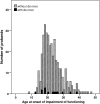De novo CNVs in bipolar affective disorder and schizophrenia
- PMID: 25055870
- PMCID: PMC4240207
- DOI: 10.1093/hmg/ddu379
De novo CNVs in bipolar affective disorder and schizophrenia
Abstract
An increased rate of de novo copy number variants (CNVs) has been found in schizophrenia (SZ), autism and developmental delay. An increased rate has also been reported in bipolar affective disorder (BD). Here, in a larger BD sample, we aimed to replicate these findings and compare de novo CNVs between SZ and BD. We used Illumina microarrays to genotype 368 BD probands, 76 SZ probands and all their parents. Copy number variants were called by PennCNV and filtered for frequency (<1%) and size (>10 kb). Putative de novo CNVs were validated with the z-score algorithm, manual inspection of log R ratios (LRR) and qPCR probes. We found 15 de novo CNVs in BD (4.1% rate) and 6 in SZ (7.9% rate). Combining results with previous studies and using a cut-off of >100 kb, the rate of de novo CNVs in BD was intermediate between controls and SZ: 1.5% in controls, 2.2% in BD and 4.3% in SZ. Only the differences between SZ and BD and SZ and controls were significant. The median size of de novo CNVs in BD (448 kb) was also intermediate between SZ (613 kb) and controls (338 kb), but only the comparison between SZ and controls was significant. Only one de novo CNV in BD was in a confirmed SZ locus (16p11.2). Sporadic or early onset cases were not more likely to have de novo CNVs. We conclude that de novo CNVs play a smaller role in BD compared with SZ. Patients with a positive family history can also harbour de novo mutations.
© The Author 2014. Published by Oxford University Press.
Figures
References
-
- Smoller J.W., Finn C.T. Family, twin, and adoption studies of bipolar disorder. Am. J. Med. Genet. C Semin. Med. Genet. 2003;123C:48–58. - PubMed
-
- McGuffin P., Rijsdijk F., Andrew M., Sham P., Katz R., Cardno A. The heritability of bipolar affective disorder and the genetic relationship to unipolar depression. Arch. Gen. Psychiatry. 2003;60:497–502. - PubMed
-
- Potash J.B., Toolan J., Steele J., Miller E.B., Pearl J., Zandi P.P., Schulze T.G., Kassem L., Simpson S.G., Lopez V., et al. The bipolar disorder phenome database: a resource for genetic studies. Am. J. Psychiatry. 2007;164:1229–1237. - PubMed
Publication types
MeSH terms
Grants and funding
LinkOut - more resources
Full Text Sources
Other Literature Sources
Medical



